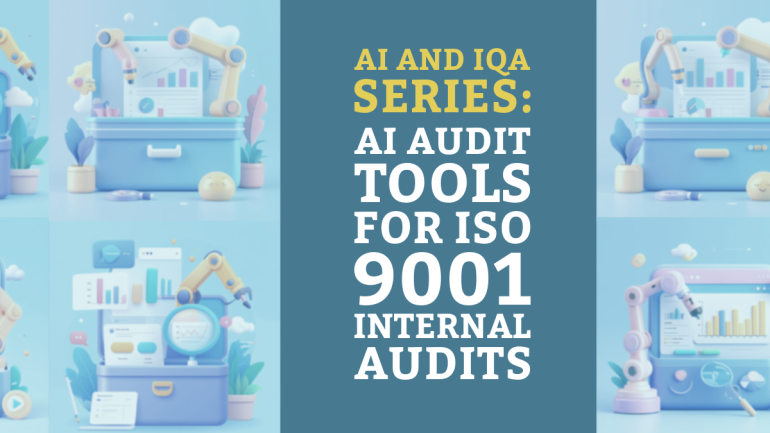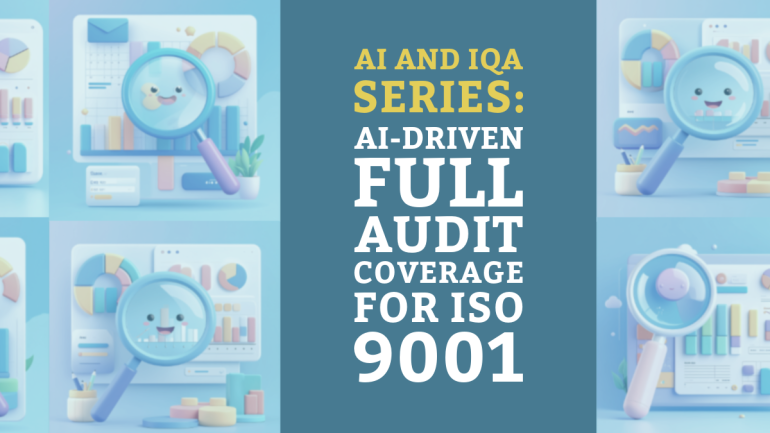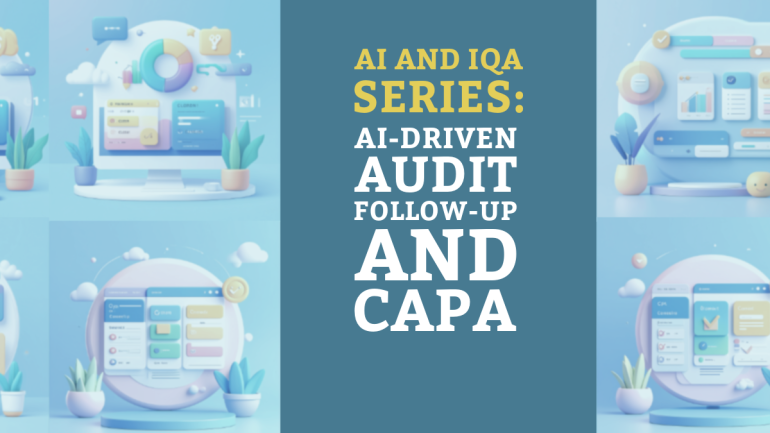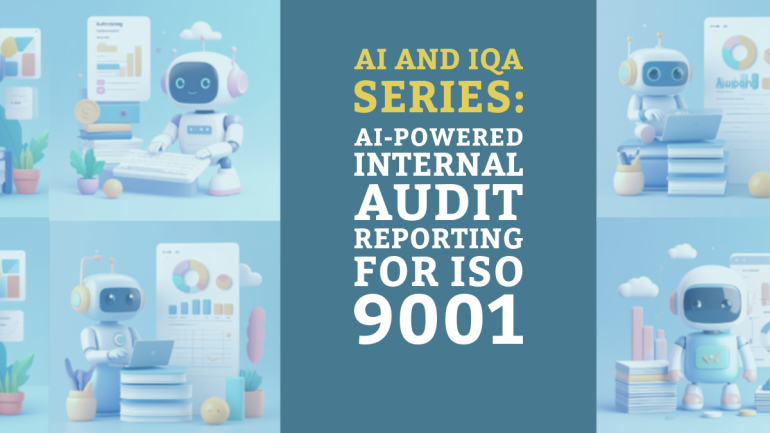Table of Contents
TL;DR: 10 AI Audit Tools to Enhance ISO 9001 Internal Audits and Meet ISO 19011 Guidelines
- AI-powered audit tools are streamlining ISO 9001 internal audits across Asia by automating planning, data testing, reporting, and CAPA management in alignment with ISO 19011.
- Leading tools such as SafetyCulture (iAuditor), MetricStream, AuditBoard, and MindBridge are used in sectors like manufacturing, finance, healthcare, and education.
- Organizations in Singapore, Japan, South Korea, and Malaysia are adopting AI solutions to move from sample-based audits to full-data analysis, improving audit coverage and risk detection.
- Efficiency, consistency, and proactive quality assurance are the primary benefits, with real-world examples showing savings of hundreds of audit hours and improved compliance visibility.
Internal auditors are increasingly leveraging AI-powered tools to enhance ISO 9001 Quality Management System audits. These tools streamline audit planning, automate testing of large datasets, and expedite reporting in line with ISO 19011 guidelines. By adopting AI, auditors can focus on high-risk areas and improve accuracy. Below are 10 notable AI audit tools used or emerging, with their use cases in Internal Quality Assurance (IQA), pros, cons, and real-world usage where available.
1. SafetyCulture (iAuditor)
SafetyCulture’s iAuditor is a mobile-first audit and inspection platform popular across APAC for internal quality audits. It provides digital checklists and templates for ISO standards, including ISO 9001, enabling consistent audits across multiple sites. Auditors can conduct on-site inspections via smartphones or tablets (even offline) and sync results to the cloud for analysis. The platform’s analytics dashboard helps identify patterns or recurring non-conformances, supporting the ISO 19011 focus on evidence-based improvement. A Forrester study found that using iAuditor saved a mid-sized company over half a million dollars in three years through efficiency gains and improved compliance. Companies from manufacturing plants to hotels use iAuditor to simplify internal Quality Assurance checks and track corrective actions on a single platform.
- Pros: Intuitive mobile app and interface (minimal training needed); extensive library of audit templates (including ISO 9001 checklists out-of-the-box); real-time analytics to spot trends and issues across locations; facilitates quick follow-up by allowing assignment of corrective actions with photos and notes.
- Cons: Analytics are primarily descriptive rather than predictive AI; may not handle complex audit program management for large enterprises; some advanced features require premium subscription.
For more information: SafetyCulture (iAuditor)
2. MetricStream
MetricStream is an enterprise Governance, Risk, and Compliance (GRC) software suite that includes robust internal audit management capabilities. In Asia, banks and telecom firms have adopted MetricStream to drive risk-based internal audits aligned with ISO 19011’s guidance on focusing audit resources where the risks are highest. The platform is AI-equipped, using machine learning and analytics to help auditors prioritize high-risk auditable entities and automate routine checks. Audit planning is streamlined by structuring the “audit universe” and scheduling in one system, and auditors can collaborate through a centralized workspace. MetricStream’s AI capabilities also support continuous auditing—e.g. automatically flagging anomalies in process data or quality KPIs in real time.
- Pros: Comprehensive GRC integration; AI-driven insights to make auditing more efficient; strong support for risk-based audit planning; scalable for large organizations.
-
Cons: Implementation can be complex and costly; steep learning curve; interface may feel less intuitive than newer audit apps.
For more information: MetricStream
3. AuditBoard
AuditBoard is a cloud-based platform for internal audit, risk, and compliance management. It supports end-to-end workflows—from planning and risk assessment to workpaper management, issue tracking, and reporting. AuditBoard’s automated workflows (routing, reminders) and integration with analytics tools help identify trends and ensure consistent audit execution, aligning with ISO 19011. Audit teams in Singapore and Japan use AuditBoard to replace manual spreadsheets and improve documentation rigor.
- Pros: User-friendly, modern SaaS design; comprehensive program management; automated workflows reduce manual follow-ups; robust reporting dashboards.
- Cons: Advanced AI analytics are limited; enterprise-level pricing; customization and integrations may require time and resources.
For more information: AuditBoard
4. Wolters Kluwer TeamMate
TeamMate+ by Wolters Kluwer is a long-established audit management system used globally—including Asia’s financial and government sectors. It offers planning, resourcing, documentation, and remediation tracking. Recent analytics features (TeamMate Analytics) can run data tests on financial and operational data to identify anomalies and potential red flags in line with risk-based audit approaches.
- Pros: Comprehensive workflow management; built-in analytics to highlight unusual trends; proven, mature platform.
- Cons: Interface can feel dated; configuration/maintenance may need dedicated support; not specifically tailored to ISO 9001 checklists without user configuration.
For more information: Wolters Kluwer TeamMate
5. Diligent AuditBond (Galvanize)
AuditBond (formerly Galvanize HighBond) is known for its analytics and automation. It provides real-time dashboards and risk heatmaps, leveraging its ACL heritage to directly analyze large datasets using AI techniques like pattern recognition. For IQA, auditors can continuously monitor quality metrics and get alerts on anomalies without manual data review, while linking findings to enterprise risk registers.
- Pros: Powerful analytics engine; real-time reporting; strong security; multi-standard audit support.
- Cons: Complex test setup requiring analytics expertise; UI less slick than newer tools; full capabilities require higher-tier packages.
For more information: Diligent AuditBond (Galvanize)
6. Hyperproof
Hyperproof is a compliance and audit management platform ideal for managing multiple frameworks (ISO 9001, ISO 27001, local regs) in one place. It maps controls across standards to avoid duplication, aligns with ISO 19011’s combined-audit guidance, and offers automated evidence collection so auditors get real-time visibility into compliance status.
- Pros: Excellent multi-framework support; automated workflows; centralized risk tracking.
- Cons: Some advanced features still evolving; limited local support in Asia; pricing not public.
For more information: Hyperproof
7. Workiva
Workiva’s cloud platform links audit procedures directly to live business data (ERP, complaints databases), eliminating manual entry and ensuring consistency across workpapers and reports. Emerging AI-enhanced text analytics help detect narrative inconsistencies, supporting ISO 19011’s documentation reliability principle.
- Pros: Eliminates manual effort via data integrations; cross-functional audit capability; strong collaboration features.
- Cons: High cost and complexity; setup time for data system integrations; predictive analytics are nascent.
For more information: AuditBoard
8. QT9 QMS
QT9 QMS is an all-in-one Quality Management System with audit, document control, CAPA modules—popular in manufacturing and healthcare for ISO 9001. It automates audit scheduling, checklist management, links findings directly into CAPA tasks, and runs on any device via the cloud.
- Pros: Purpose-built for ISO compliance; integrates audit with CAPA; automated recurring audits; user-friendly cloud access.
- Cons: Less suited for broad corporate audits; limited AI/predictive analytics; few ERP/BI integrations.
For more information: QT9 QMS
9. EHS Insight
EHS Insight covers Environment, Health, Safety, and Quality—making it a one-stop for integrated audits. Its mobile app supports offline data capture; dashboards identify frequent findings and incident trends, encouraging a proactive approach aligned with continual improvement.
- Pros: Broad EHS+Quality coverage; strong mobile/offline auditing; real-time dashboards; flat pricing.
- Cons: Can be overwhelming if only ISO 9001 audit needed; limited system integrations; AI features limited to basic analytics.
For more information: EHS Insight
10. MindBridge AI Auditor
MindBridge applies ML and statistical models to score the risk of each transaction—traditionally for financial audits but now also for IQA. By analyzing 100% of the data, it uncovers subtle anomalies and aligns with ISO 19011’s evidence-based principle. Global usage exceeds 100 billion entries, showing its scalability.
- Pros: Advanced AI/ML analytics; near-total data coverage; intuitive risk scoring and visualizations.
- Cons: Not a full audit management system; requires high-quality data prep; customization needed for non-financial data.
For more information: MindBridge AI Auditor
FAQs
1. How does AI improve ISO 9001 internal audit processes?
AI automates repetitive tasks (checklists, transaction analysis, anomaly detection, report drafting), freeing auditors to focus on strategic risk areas and root-cause analysis.
2. Are AI audit tools suitable for smaller organizations?
Yes—tools like SafetyCulture (iAuditor) and QT9 QMS scale for SMEs, though enterprise suites like MetricStream suit larger regulated firms.
3. How does AI audit testing align with ISO 19011 guidelines?
AI tools enable full-population testing, evidence-based risk prioritization, real-time anomaly detection, and systematic reporting, while still requiring human oversight.
4. What sectors in Asia are leading in AI audit adoption for ISO 9001?
Manufacturing, financial services, and healthcare in Singapore, Japan, South Korea, and Malaysia are at the forefront of AI-driven IQA.
5. Can AI fully replace auditors in ISO 9001 compliance audits?
No—AI is an enabler, not a replacement. Auditors must validate AI findings, exercise professional judgment, and interpret nuanced organizational risks as per ISO 19011.




